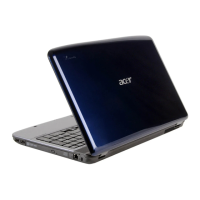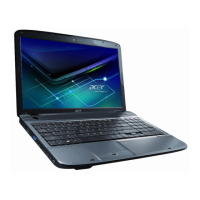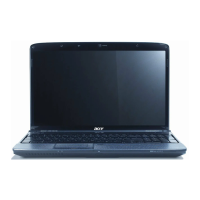
Do you have a question about the Acer Aspire 5738G Series and is the answer not in the manual?
| Storage | 320GB HDD |
|---|---|
| Operating System | Windows Vista Home Premium |
| Battery | 6-cell Li-ion battery |
| LAN | Gigabit Ethernet |
| Webcam | Acer Crystal Eye webcam |
| Card Reader | 5-in-1 card reader (SD, MMC, MS, MS PRO, xD) |
| Graphics | ATI Mobility Radeon HD 4570 |
| Display | 15.6" HD (1366 x 768) Acer CineCrystal LED-backlit TFT LCD |
| RAM | Up to 4GB DDR3 |
| Optical Drive | DVD-Super Multi double-layer drive |
| Chipset | Intel PM45 |
| Wireless | 802.11b/g/n |
| Ports | 3 x USB 2.0, 1 x HDMI, 1 x VGA, 1 x Ethernet, 1 x Headphone, 1 x Microphone |
| Weight | 2.8 kg |
| Processor | Intel Core 2 Duo |
Summary of computer features.
Information about the processor and chipset.
Details on system memory types and capacities.
Specifications for display resolution, aspect ratio, and graphics controller.
Details on hard disk drive and optical drive options.
Description of special keys and pointing devices.
Information on the audio system, speakers, and microphone.
Details on communication features like webcam and wireless modules.
List and description of all input/output ports.
Physical dimensions and weight of the notebook.
System block diagram specific to Intel-based models.
System block diagram specific to AMD-based models.
System block diagram specific to AMD-based models.
Visual guide to the notebook's front view and component identification.
Visual guide to the notebook's closed front view.
Visual guide to the notebook's left view and ports.
Visual guide to the notebook's right view and ports.
Visual guide to the notebook's bottom view and components.
Details on special function buttons located above the keyboard.
Instructions on how to use the touchpad and its buttons.
Explanation of Caps Lock, Num Lock, and the embedded numeric keypad.
Description of Windows-specific function keys and shortcuts.
Explanation of function key combinations for system controls.
Information on special keyboard keys like Euro symbol or dollar sign.
Explanation of the dual-display utility for managing multiple monitors.
Detailed specifications for the CPU types used in different models.
Information on the core logic chipsets used in various models.
Details about the CPU package type.
Information on the voltage requirements for the CPU.
Table showing fan speed and acoustic levels at different temperatures.
Information about the BIOS vendor and version.
Guide to accessing and using the BIOS setup program.
Instructions on navigating BIOS setup menus and options.
Screen displaying summary of computer hardware information.
Screen for setting system time, date, and boot options.
Screen for setting system passwords to safeguard against unauthorized use.
Menu to decide the order of boot devices for loading the operating system.
Screen for confirming or discarding BIOS setup changes.
Procedure for updating the system BIOS flash memory.
Instructions on how to remove an HDD password.
Tools and preparations needed before disassembling the computer.
General guidelines and notes for disassembly procedures.
Steps to take before starting the disassembly process.
Overview of the stages involved in computer disassembly.
Procedures for removing external components from the notebook.
Flowchart illustrating the sequence for external module disassembly.
Step-by-step guide to remove the notebook's battery pack.
Instructions for removing the SD dummy card.
Step-by-step guide to remove the RAM (DIMM) module.
Procedure for removing the notebook's back cover.
Step-by-step instructions to remove the hard disk drive module.
Procedure for removing the Wireless LAN modules.
Instructions for removing the optical drive module.
Procedures for disassembling the main internal components of the notebook.
Flowchart illustrating the main unit disassembly sequence.
Steps to remove the middle cover of the notebook.
Step-by-step guide to remove the notebook keyboard.
Procedure for removing the LCD module from the notebook.
Instructions on how to separate the main chassis components.
Procedures for removing the fingerprint reader and touchpad components.
Steps to remove the left speaker module.
Instructions for removing the USB board module.
Procedure for removing the modem module.
Steps to remove the Bluetooth module.
Procedures for removing the right speaker module.
Step-by-step guide to remove the notebook's main logic board.
Instructions for removing the heatsink module, including fan.
Procedures for removing the Central Processing Unit (CPU).
Detailed process for disassembling the LCD module.
Flowchart illustrating the LCD module disassembly steps.
Step-by-step guide to remove the LCD bezel.
Procedure for removing the inverter board, specific to certain models.
Instructions for removing the LCD panel along with its mounting brackets.
Procedures for removing the LCD mounting brackets separately.
Steps to remove the Flexible Printed Circuit (FPC) cable.
Procedures for removing the wireless antennas.
Instructions for removing the web camera module.
Steps for checking system components and diagnosing issues.
Procedure to check system memory (RAM) for errors.
Steps to verify power supply sources and system power-on behavior.
Index of error messages displayed during POST and their causes.
A list of error codes, messages, and their potential FRU actions.
Table listing BIOS beep codes and their corresponding POST routine descriptions.
Cross-reference of symptoms to potential FRU (Field Replaceable Unit) replacements.
Troubleshooting guide for problems that occur sporadically.
Procedures to follow when the cause of a problem cannot be identified.
Diagram showing connector locations on the main system board.
Illustration of connectors on the top side of the main board.
Illustration of connectors on the bottom side of the main board.
Procedures for clearing system passwords.
Detailed steps to bypass or clear BIOS passwords.
Procedures for recovering the BIOS using a crisis disk.
Guide on how to create a crisis disk for BIOS recovery.
Visual breakdown of the laptop's components with numbered references.
Comprehensive list of Field Replaceable Units with part names and Acer part numbers.
Detailed model specifications and common features for this series.
Detailed model specifications and common features for this series.
Detailed model specifications and common features for this series.
Detailed model specifications and common features for this series.
Lists of tested hardware and software components for Windows compatibility.












